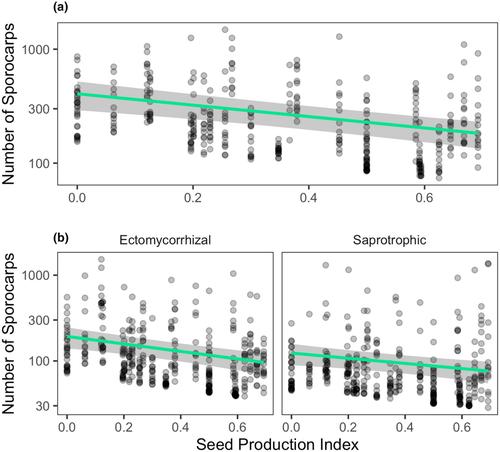当前位置:
X-MOL 学术
›
Ecol. Lett.
›
论文详情
Our official English website, www.x-mol.net, welcomes your
feedback! (Note: you will need to create a separate account there.)
Mast seeding in European beech (Fagus sylvatica L.) is associated with reduced fungal sporocarp production and community diversity
Ecology Letters ( IF 7.6 ) Pub Date : 2024-06-15 , DOI: 10.1111/ele.14460 Talia J Michaud 1 , Ian S Pearse 2 , Håvard Kauserud 3 , Carrie J Andrew 4 , Peter G Kennedy 1
Ecology Letters ( IF 7.6 ) Pub Date : 2024-06-15 , DOI: 10.1111/ele.14460 Talia J Michaud 1 , Ian S Pearse 2 , Håvard Kauserud 3 , Carrie J Andrew 4 , Peter G Kennedy 1
Affiliation

|
Mast seeding is a well-documented phenomenon across diverse forest ecosystems. While its effect on aboveground food webs has been thoroughly studied, how it impacts the soil fungi that drive soil carbon and nutrient cycling has not yet been explored. To evaluate the relationship between mast seeding and fungal resource availability, we paired a Swiss 29-year fungal sporocarp census with contemporaneous seed production for European beech (Fagus sylvatica L.). On average, mast seeding was associated with a 55% reduction in sporocarp production and a compositional community shift towards drought-tolerant taxa across both ectomycorrhizal and saprotrophic guilds. Among ectomycorrhizal fungi, traits associated with carbon cost did not explain species' sensitivity to seed production. Together, our results support a novel hypothesis that mast seeding limits annual resource availability and reproductive investment in soil fungi, creating an ecosystem ‘rhythm’ to forest processes that is synchronized above- and belowground.
中文翻译:

欧洲山毛榉(Fagus sylvatica L.)的肥大播种与真菌子实体产量和群落多样性的减少有关
肥大播种是多种森林生态系统中一种有据可查的现象。虽然它对地上食物网的影响已得到彻底研究,但它如何影响驱动土壤碳和养分循环的土壤真菌尚未得到探索。为了评估肥大播种和真菌资源可用性之间的关系,我们将瑞士 29 年的真菌子实体普查与欧洲山毛榉 ( Fagus sylvatica L.) 的同期种子生产进行了配对。平均而言,肥大播种与子实体产量减少 55% 以及外生菌根和腐生群落组成向耐旱类群的转变有关。在外生菌根真菌中,与碳成本相关的特征并不能解释物种对种子生产的敏感性。总之,我们的结果支持了一个新的假设,即肥大播种限制了土壤真菌的年度资源可用性和繁殖投资,为森林过程创造了一种地上和地下同步的生态系统“节奏”。
更新日期:2024-06-15
中文翻译:

欧洲山毛榉(Fagus sylvatica L.)的肥大播种与真菌子实体产量和群落多样性的减少有关
肥大播种是多种森林生态系统中一种有据可查的现象。虽然它对地上食物网的影响已得到彻底研究,但它如何影响驱动土壤碳和养分循环的土壤真菌尚未得到探索。为了评估肥大播种和真菌资源可用性之间的关系,我们将瑞士 29 年的真菌子实体普查与欧洲山毛榉 ( Fagus sylvatica L.) 的同期种子生产进行了配对。平均而言,肥大播种与子实体产量减少 55% 以及外生菌根和腐生群落组成向耐旱类群的转变有关。在外生菌根真菌中,与碳成本相关的特征并不能解释物种对种子生产的敏感性。总之,我们的结果支持了一个新的假设,即肥大播种限制了土壤真菌的年度资源可用性和繁殖投资,为森林过程创造了一种地上和地下同步的生态系统“节奏”。































 京公网安备 11010802027423号
京公网安备 11010802027423号